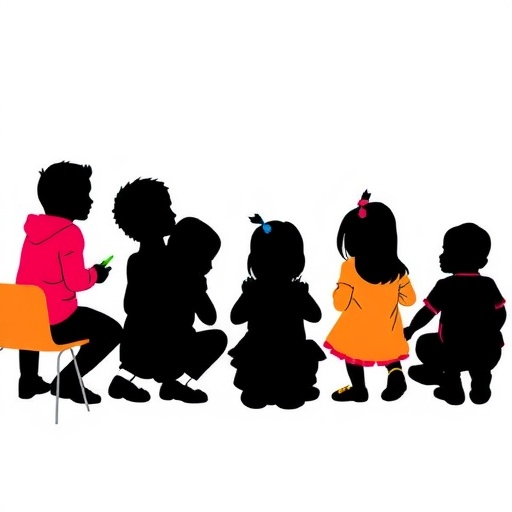In the field of early childhood education, understanding the dynamics of language development is pivotal for educators, researchers, and policymakers alike. Recent studies have proved that the language children acquire is not merely a function of innate capabilities; rather, it is deeply embedded in their daily experiences and interactions within varied activity contexts in their classrooms. This exposure influences their linguistic skills, making it essential to study these environments closely. A groundbreaking study by Schachter, Cutler, and Purtell from 2025 delves into this very issue, examining the impact of activity contexts in preschool settings on children’s language development.
The researchers aimed to illuminate how different classroom activities play distinct roles in shaping children’s language patterns. This exploration is particularly relevant in our increasingly diverse educational environments, where the interplay between culture, activity type, and language use becomes complex. By considering various activity contexts—including structured play, free play, group discussions, and story time—the authors argue that each situation cultivates a unique linguistic environment that promotes or inhibits language acquisition.
Their methodology involved analyzing interactions among children and educators across various classroom settings. They employed both observational and participatory methods, which allowed them to capture the nuanced ways language is used and developed. This approach also highlights the significance of adult-child interactions in fostering oral language skills. The researchers noted that environments rich in language exposure result in a wider vocabulary and more complex sentence structures during children’s spontaneous speech.
The study revealed a critical finding: classrooms that encourage collaborative activities—where children share ideas and work together—tend to facilitate more robust language development. This reflects Vygotskian principles of social interaction being central to learning processes, particularly in the formative years of children’s lives. Children in these cooperative contexts are more likely to engage in meaningful dialogue, reflecting a depth of understanding and an ability to articulate thoughts, feelings, and inquiries effectively.
Conversely, the researchers identified that traditional, teacher-led instructional methods could limit children’s language practice. These patterns often promote passive learning, where students listen rather than engage in dialogue. Such pronounced disparities between activity contexts paint a clear picture of how critical it is to design classrooms that promote interaction, exploration, and communication. The implications of this research are profound, particularly for curriculum developers and educators who must strike a balance between instruction and engagement.
Moreover, the paper posits that language development is not a linear process but rather a complex tapestry woven from diverse threads of experience. For instance, activities that blend artistic expression with storytelling may evoke a more profound emotional connection to the language, enabling children to relate personally to the vocabulary and concepts presented. This emotional engagement is crucial, as it fosters a love for language, making learning a joyous pursuit rather than a mere academic obligation.
Additionally, the researchers emphasized the role of cultural context in language acquisition. Children from varied backgrounds bring unique perspectives and communication styles into the classroom. Recognizing and valuing these differences can create a more inclusive environment where all children feel empowered to express themselves. This underscores the importance of professional development for educators to effectively support diverse learners and adapt their teaching methods accordingly.
The findings of Schachter et al. urge educational institutions to rethink how language is taught and fostered within early childhood settings. Attention must be directed not only towards structured curricula but also towards the holistic nature of language exposure within the school environment. This approach requires a shift in mindset, where teachers become facilitators of language-rich experiences rather than mere dispensers of knowledge.
Moreover, the study opens avenues for future research, particularly concerning the longitudinal effects of these activity contexts on children’s language abilities as they transition into later educational stages. Such inquiry could provide deeper insights into the long-term benefits of early linguistic exposure and guide educators in structuring experiences that prepare children for academic success.
The implications of the research extend beyond the classroom. Policymakers must consider these findings when crafting educational guidelines and standards. A movement toward prioritizing activity-based learning could enhance language development outcomes for children nationwide, ensuring that future generations are equipped with the verbal skills necessary to thrive in an increasingly interconnected world.
In conclusion, the work by Schachter, Cutler, and Purtell serves as a clarion call for educators to recognize the critical role of activity contexts in shaping children’s language development. By cultivating classrooms filled with diverse, engaging activities, we not only enhance learning outcomes but also nurture a generation of confident, articulate, and socially adept individuals prepared to interact meaningfully in their communities.
This study represents a vital contribution to the field of early childhood education, underscoring the significance of context in language acquisition and advocating for practices that prioritize active engagement, collaboration, and acknowledgment of linguistic diversity among young learners.
The ripple effects of such insights are truly transformative, as they hold the potential to change the fabric of early childhood education for the better, paving the way for more effective teaching practices and stronger linguistic foundations for our children.
Subject of Research: The impact of activity contexts in early childhood classrooms on children’s language development.
Article Title: Activity Contexts in Early Childhood Classrooms and Children’s Language Change.
Article References:
Schachter, R.E., Cutler, L., Purtell, K.M. et al. Activity Contexts in Early Childhood Classrooms and Children’s Language Change.
Early Childhood Educ J (2025). https://doi.org/10.1007/s10643-025-02053-z
Image Credits: AI Generated
DOI: https://doi.org/10.1007/s10643-025-02053-z
Keywords: early childhood education, language development, activity contexts, children’s language change, educational practices, collaborative learning, linguistic diversity.




